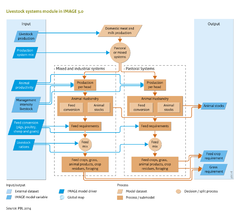Livestock systems: Difference between revisions
Jump to navigation
Jump to search
m (Text replace - "|Status=On hold" to "") |
No edit summary |
||
| Line 1: | Line 1: | ||
{{ComponentTemplate2 | {{ComponentTemplate2 | ||
|Application=Roads from Rio+20 (2012); Global Environmental Outlook - GEO4; Millennium Ecosystem Assessment; OECD Environmental Outlook to 2030 (2008); OECD Environmental Outlook to 2050 (2012); Resource Efficiency; Global Environmental Outlook - GEO3; | |Application=Roads from Rio+20 (2012); Global Environmental Outlook - GEO4; Millennium Ecosystem Assessment; OECD Environmental Outlook to 2030 (2008); OECD Environmental Outlook to 2050 (2012); Resource Efficiency; Global Environmental Outlook - GEO3; | ||
|IMAGEComponent=Scenario drivers; Agricultural economy and forestry; Agricultural systems; Agriculture and land use; Atmospheric composition and climate; Crop and grass; | |IMAGEComponent=Scenario drivers; Agricultural economy and forestry; Agricultural systems; Agriculture and land use; Atmospheric composition and climate; Crop and grass; | ||
|ExternalModel=New | |||
|KeyReference=Bouwman et al., 2005; | |KeyReference=Bouwman et al., 2005; | ||
|Reference=Bruinsma, 2003; Bouwman et al., 2006; Bouwman et al., 2005; Delgado et al., 1999; Seré and Steinfeld, 1996; | |Reference=Bruinsma, 2003; Bouwman et al., 2006; Bouwman et al., 2005; Delgado et al., 1999; Seré and Steinfeld, 1996; | ||
| Line 17: | Line 14: | ||
#on a more local scale, odour nuisance and leaching of nitrate to groundwater are major problems; | #on a more local scale, odour nuisance and leaching of nitrate to groundwater are major problems; | ||
#a significant amount of land that is used for grazing ruminants may consist of marginal unproductive grassland with a low carrying capacity and high risk of land degradation due to overgrazing, especially in the arid and semi-arid tropics and subtropics ([[Seré and Steinfeld, 1996]] [[Delgado et al., 1999]]). To compensate for productivity losses in such areas, forests may be cleared to expand agricultural land areas. | #a significant amount of land that is used for grazing ruminants may consist of marginal unproductive grassland with a low carrying capacity and high risk of land degradation due to overgrazing, especially in the arid and semi-arid tropics and subtropics ([[Seré and Steinfeld, 1996]] [[Delgado et al., 1999]]). To compensate for productivity losses in such areas, forests may be cleared to expand agricultural land areas. | ||
|ComponentCode=LS | |||
|AggregatedComponent=Agriculture and land use | |||
|FrameworkElementType=pressure component | |||
|LeadText=What are the impacts on land-use, greenhouse gases and other emissions to air, land and surface water of increasing livestock production? And how may use of marginal lands for grazing increase the risk of degradation and loss of productivity, inducing more forest clearing. | |LeadText=What are the impacts on land-use, greenhouse gases and other emissions to air, land and surface water of increasing livestock production? And how may use of marginal lands for grazing increase the risk of degradation and loss of productivity, inducing more forest clearing. | ||
}} | }} | ||
Revision as of 10:06, 8 January 2014
Parts of Livestock systems
| Component is implemented in: |
| Components: |
| Related IMAGE components |
| Projects/Applications |
|
| Models/Databases |
| Key publications |
| References |
Key policy issues
- What are the impacts of increasing livestock production on land use, greenhouse gases and other emissions to air and surface water?
- How does the use of marginal lands for grazing increase the risk of degradation and loss of productivity, inducing more forest clearing?
